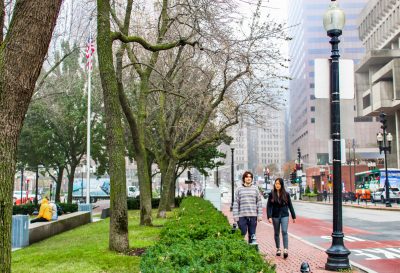Mayor Michelle Wu announced Boston’s new green infrastructure policy on Friday, which included upgraded stormwater filtration designs and curb extensions.

“Fundamentally, green infrastructure features are stormwater management features that mimic nature,” Kate England, Boston’s inaugural director of green infrastructure, said at a press conference on Friday. “They use plants and soil and other materials to help stormwater absorb back into the ground.”
The Boston Water and Sewer Commission’s website explains that the natural processes of nature cannot occur as easily in cities such as Boston.
“In most cities and towns rainwater can no longer infiltrate into the ground because of buildings, pavement, sidewalks and other surfaces that water cannot pass through,” the website reads.
The City plans on introducing green infrastructure to curb extensions as a way to mitigate urban runoff. Five new standards, including tree trenches, porous paving and one-time seeding with groundcover, will apply to the curb extensions currently in design, according to the Mayor’s press office.
David Hsu, associate professor of urban and environmental planning at the Massachusetts Institute of Technology, said older cities such as Boston have “combined sewer systems,” where rainwater and sewage water enter into the same drains. These systems can overflow as extreme weather events become more common as a result of climate change.
“Green infrastructure is meant, generally, to slow down how much water goes into the sewer system, or give it other ways to infiltrate into the ground,” Hsu said.
Emily Norton, executive director of the Charles River Watershed Association, wrote in an email that green infrastructure improves water quality in the Charles River by allowing stormwater to infiltrate into the ground and filter it with soil before entering into the river.
“By redirecting water away from storm drains, [green infrastructures] reduce the likelihood of flooding,” Norton wrote. “More intense rainstorms are overwhelming our storm drains which were not built for the capacity of intense rainstorms we are already seeing from climate change.”
More types of green infrastructure also help mitigate the effects of climate change through increasing tree canopy cover, reducing the urban heat island effect and providing access to green areas in a dense urban environment, England said in the press conference.
Neil Rhein, founder and executive director of Keep Massachusetts Beautiful, said maintaining plants is one of the challenges in public green infrastructure.
“It might look great on day one, but six months later it’s weed infested, litter infested,” Rhein said. “So maintenance is key, and it’s good to see that the mayor has thought that through.”
The City’s two planned maintenance contracts included in the plan are a regenerative air vacuum that removes dirt and small particles from porous paving materials, and landscape maintenance to ensure the new vegetation added is maintained, England also said during the press conference.
England wrote that Boston is working on becoming a Green New Deal City, and that through this infrastructure they will come closer to achieving this goal.
“The City is pursuing a ‘green economy’ and sustainable communities,” England wrote in an email. “A series of unfortunate circumstances makes it essential to change the way cities perform daily activities, such that green infrastructure and climate resilience are incorporated into everything that we do.”
The City of Boston’s open streets initiative during the summer also helps to show residents how their streets could be used in environmentally friendly ways.
“By allowing communities to experience the public realm in a new and different way, they’re able to reconsider what is possible, as well as how we allocate space within the public (rights of way),” England wrote.
Hsu said stormwater management is important in solving water pollution as a national problem.
“In the U.S., stormwater runoff is the second biggest contribution to water pollution,” Hsu said. “What we’re trying to do is stop the second biggest portion of water pollution by simply making sure that we either treat the water or we don’t create the problem in the first place.”





















































































































